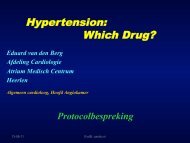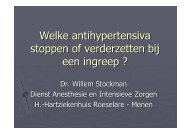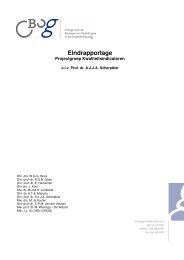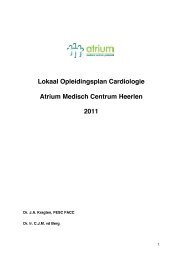Guidelines on the Management of Stable Angina Pectoris ... - Cardio
Guidelines on the Management of Stable Angina Pectoris ... - Cardio
Guidelines on the Management of Stable Angina Pectoris ... - Cardio
Create successful ePaper yourself
Turn your PDF publications into a flip-book with our unique Google optimized e-Paper software.
ESC <str<strong>on</strong>g>Guidelines</str<strong>on</strong>g> 37(2) Test <strong>the</strong> effects <strong>of</strong> a beta-1 blocker, and titrate to fulldose; c<strong>on</strong>sider <strong>the</strong> need for 24 h protecti<strong>on</strong> againstischaemia (level <strong>of</strong> evidence A)(3) In case <strong>of</strong> beta-blocker intolerance or poor efficacyattempt m<strong>on</strong>o<strong>the</strong>rapy with a CCB (level <strong>of</strong> evidence A),l<strong>on</strong>g-acting nitrate (level <strong>of</strong> evidence C), or nicorandil(level <strong>of</strong> evidence C)(4) If <strong>the</strong> effects <strong>of</strong> beta-blocker m<strong>on</strong>o<strong>the</strong>rapy are insufficient,add a dihydropyridine CCB (level <strong>of</strong> evidence B)Class IIa(1) In case <strong>of</strong> beta-blocker intolerance try sinus nodeinhibitor (level <strong>of</strong> evidence B)(2) If CCB m<strong>on</strong>o<strong>the</strong>rapy or combinati<strong>on</strong> <strong>the</strong>rapy (CCB withbeta-blocker) is unsuccessful, substitute <strong>the</strong> CCB with al<strong>on</strong>g-acting nitrate or nicorandil. Be careful to avoidnitrate tolerance (level <strong>of</strong> evidence C)Class IIb(1) Metabolic agents may be used, where available, asadd-<strong>on</strong> <strong>the</strong>rapy, or as substituti<strong>on</strong> <strong>the</strong>rapy when c<strong>on</strong>venti<strong>on</strong>aldrugs are not tolerated (level <strong>of</strong> evidence B)C<strong>on</strong>sider triple <strong>the</strong>rapy <strong>on</strong>ly if optimal two drug regimensare insufficient, and evaluate <strong>the</strong> effects <strong>of</strong> additi<strong>on</strong>al drugscarefully. Patients whose symptoms are poorly c<strong>on</strong>trolled <strong>on</strong>double <strong>the</strong>rapy should be assessed for suitability for revascularizati<strong>on</strong>,as should those who express a str<strong>on</strong>g preferencefor revascularizati<strong>on</strong> ra<strong>the</strong>r than pharmacological<strong>the</strong>rapy. The <strong>on</strong>going need for medicati<strong>on</strong> to improve prognosisirrespective <strong>of</strong> revascularizati<strong>on</strong> status, and <strong>the</strong>balance <strong>of</strong> risk and benefit <strong>on</strong> an individual basis, shouldbe explained in detail. Despite <strong>the</strong> array <strong>of</strong> <strong>the</strong>rapeuticopti<strong>on</strong>s outlined, <strong>the</strong> management <strong>of</strong> refractory angina c<strong>on</strong>tinuesto pose a challenge, and management opti<strong>on</strong>s in suchcases are outlined in a separate secti<strong>on</strong> below.Special <strong>the</strong>rapeutic c<strong>on</strong>siderati<strong>on</strong>s: cardiac Syndrome Xand vasospastic anginaTreatment <strong>of</strong> Syndrome X. Treatment should focus <strong>on</strong> symptomaticrelief. 532 As nitrates are effective in about half <strong>of</strong> <strong>the</strong>patients, 303,532 it is reas<strong>on</strong>able to start treatment withl<strong>on</strong>g-acting nitrates. If symptoms persist, calcium antag<strong>on</strong>ists533 and b-blockers, 534 which are beneficial in Syndrome Xpatients, may be added. Although a-adrenergic blockadeincreases vasodilator reserve in patients with Syndrome X, 535a-adrenergic blocking agents are clinically inefficient. 536,537There are reports that o<strong>the</strong>r drugs such as nicorandil 538 andtrimetazidine 539 might be helpful in some patients.ACE-inhibitors 540 and statins 541 are helpful to reverseunderlying endo<strong>the</strong>lial dysfuncti<strong>on</strong>. Thus, <strong>the</strong>se drugsshould be actively c<strong>on</strong>sidered for patients with Syndrome Xas part <strong>of</strong> <strong>the</strong>ir risk factor management, 542 and <strong>the</strong>re aresome data to suggest that ACE-inhibitors and statins mayalso be beneficial in reducing exercise-induced ischaemia inthis populati<strong>on</strong>. 541,543,544The challenge <strong>of</strong> achieving l<strong>on</strong>g-lasting <strong>the</strong>rapeutic effectsin patients with Syndrome X requires a multidisciplinaryapproach. 545 This might include analgesic interventi<strong>on</strong>using imipramine 546 or aminophylline, 547 psychological interventi<strong>on</strong>,545 electrostimulati<strong>on</strong> techniques, 548 and physicaltraining. 549 Some studies <strong>of</strong> transdermal horm<strong>on</strong>e replacement<strong>the</strong>rapy 550,551 in post-menopausal patients haveshown an improvement in endo<strong>the</strong>lial functi<strong>on</strong> and symptoms,but in <strong>the</strong> light <strong>of</strong> recent trials documenting adversecardiovascular outcomes with <strong>the</strong> use <strong>of</strong> HRT, cauti<strong>on</strong> isadvised in prescripti<strong>on</strong> <strong>of</strong> HRT for this purpose.Recommendati<strong>on</strong>s for pharmacological <strong>the</strong>rapy toimprove symptoms in patients with Syndrome XClass I(1) Therapy with nitrates, b-blockers, and calcium antag<strong>on</strong>istsal<strong>on</strong>e or in combinati<strong>on</strong> (level <strong>of</strong> evidence B)(2) Statin <strong>the</strong>rapy in patients with hyperlipidaemia (level<strong>of</strong> evidence B)(3) ACE inhibiti<strong>on</strong> in patients with hypertensi<strong>on</strong> (level <strong>of</strong>evidence C)Class IIa(1) Trial <strong>of</strong> <strong>the</strong>rapy with o<strong>the</strong>r anti-anginals includingnicorandil and metabolic agents (level <strong>of</strong> evidence C)Class IIb(1) Aminophylline for c<strong>on</strong>tinued pain, despite Class Imeasures (level <strong>of</strong> evidence C)(2) Imipramine for c<strong>on</strong>tinued pain, despite Class Imeasures (level <strong>of</strong> evidence C)Treatment <strong>of</strong> vasospastic angina. Removal <strong>of</strong> precipitatingfactors such as cessati<strong>on</strong> <strong>of</strong> smoking is essential. 552 Themain elements <strong>of</strong> drug <strong>the</strong>rapy are nitrates and calciumantag<strong>on</strong>ists. Although nitrates are highly effective in abolishingacute vasospasm, <strong>the</strong>y are not as successful in preventingattacks <strong>of</strong> resting angina. 340 CCBs are moreeffective in alleviating <strong>the</strong> signs and symptoms <strong>of</strong> cor<strong>on</strong>aryspasm and treatment should be aimed at using high doses(up to 480 mg/d verapamil, up to 260 mg/d diltiazem, upto 120 mg/d nifedipine). However, calcium antag<strong>on</strong>istsachieve a complete resoluti<strong>on</strong> <strong>of</strong> symptoms in <strong>on</strong>ly 38% <strong>of</strong>patients. 340 In most patients, a combinati<strong>on</strong> <strong>the</strong>rapy withl<strong>on</strong>g-acting nitrates and high doses <strong>of</strong> calcium antag<strong>on</strong>istswill result in an improvement <strong>of</strong> symptoms. In patientswith resistant symptoms, additi<strong>on</strong> <strong>of</strong> a sec<strong>on</strong>d calciumantag<strong>on</strong>ist <strong>of</strong> ano<strong>the</strong>r class may be successful. Medical treatmentseems to be more effective in women and in patientswith ST-elevati<strong>on</strong> during provocati<strong>on</strong> testing. 340The role <strong>of</strong> a-blockers is c<strong>on</strong>troversial but occasi<strong>on</strong>al<strong>the</strong>rapeutic benefit has been reported. 553 Nicorandil, a potassiumchannel activator, may also be useful in occasi<strong>on</strong>alpatients with refractory vasospastic angina. 554 Reports <strong>of</strong>success in treating drug-resistant focal vasospasm by cor<strong>on</strong>aryartery stenting exist, 555,556 but this approach is notadvocated for widespread applicati<strong>on</strong>. CABG is not indicatedbecause spasm distal to <strong>the</strong> anastomosis may occur.Sp<strong>on</strong>taneous remissi<strong>on</strong> <strong>of</strong> spasmodicity occurs in abouthalf <strong>of</strong> western people following medical treatment for atleast 1 year. 557 Thus, it is acceptable to taper and disc<strong>on</strong>tinuetreatment 6–12 m<strong>on</strong>ths after angina has disappeared<strong>on</strong> drug treatment. If vasospasm occurs in associati<strong>on</strong> withsignificant cor<strong>on</strong>ary disease, guideline recommendati<strong>on</strong>sfor treatments to improve prognosis and sec<strong>on</strong>dary preventi<strong>on</strong>should also be adhered to.Recommendati<strong>on</strong>s for pharmacological <strong>the</strong>rapy <strong>of</strong>vasospastic anginaClass I














